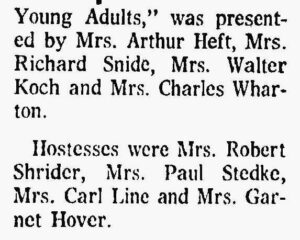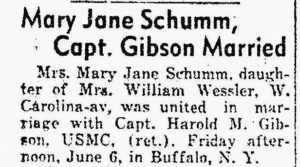I am old enough to remember when married women did not use their given names. Years ago, wives referred to themselves, and were referred to by others, with their husband’s given name. It was Mrs. John Doe, not Mrs. Jane Doe.
My mom did that same thing. She did not refer to herself as Mrs. Florence Miller, but she called herself Mrs. Herbert Miller. All married women of that time period did that.
There are plenty of examples of this in older newspapers:

Lima News, 3 Sep 1961

Lima News, 12 May 1971
That was the way things were for many years, even centuries, but that all began to change in the 1970s.
But why? Why did married women use their husband’s given name?
This custom started in the Middle Ages, with the Law of Coverture, a set of laws that said that a married woman’s identity was “covered” by her husband and her legal rights were governed by her husband. This legal status was called feme covert, literally “covered woman.” Upon marriage the wife gave up her separate and legal identity and her husband had complete legal and economic control over her. Everything she did legally had to be in her husband’s name since she was a non-person under the law.
Because she was not legally a person, she could not own any property, make decisions for her children against her husband’s wishes, sign legal documents, enter into contracts, keep her own salary, or get any education against her husband’s wishes. And she had to use her husband’s given name.
However, there was an advantage for unmarried women, who were called feme sole under the Law of Coverture. An unmarried woman was recognized as an individual person and was able to own property and sign contracts in her own name.
As time went on, the Laws and Doctrine of Coverture slowly went away, beginning with the passing of women’s property acts in the mid-19th century.
All that ultimately determined how society and newspapers referred to women years ago.
Newspapers use stylebooks to govern precisely how to use words. Stylebooks are reference books for writers, editors, and publishers. Stylebooks cover grammar, punctuation, footnotes, words, and just about anything else concerned with writing. Stylebooks evolve with customs and language. My go-to stylebook is The Chicago Manual of Style.
In the early 1960s stylebooks required that Mrs. was never to be used with the Christian name of a woman. A married woman’s name was to be written as Mrs. John Doe, not Mrs. Jane Doe.
By the late 1960s women could occasionally use their first name without the Miss or Mrs. (e.g. Jane Doe), but Mrs. was to be used when her name was used in conjunction with her husband’s name.
By the 1970’s, stylebooks stated that if the couple was divorced a woman should use her first name with Mrs., e.g. Mrs. Jane Doe. A married woman or a widow should still be referred to by her husband’s Christian name, e.g. Mrs. John Doe.
Finally, by the early 1990s married women were to be referred to by their own first name and surname, e.g. Mrs. Jane Doe or Jane Doe. They did not have to use their husband’s given name.
All this leads up to how to interpret this news article I recently found. It didn’t make sense until I learned the writing style of that time period.

Lima News, 11 June 1947
My first thought was that Mrs. Mary Jane Schumm should not marry someone else if she was already Mrs. Schumm. By today’s standards, it appears that she was married to Mr. Schumm.
But it makes sense for an article written in 1947. According to the stylebooks of the time, Mrs. Mary Jane Schumm was a divorced woman and she married again. At that time a divorced woman used Mrs. and her given name.
All this is just a little something to help interpret what was written years ago.
By the way, I always enjoyed grammar in school.
Sources: The Art of Editing, Floyd K. Baskette & Jack Z. Scissors and “Starting in the ‘70s, married women’s first names were included in Post’s references,” John Kelly, 23 Nov 2019; WashingtonPost.com.



2 comments
Hi Karen,
Loved this post, Karen!
Re tombstones: I’ve often puzzled over listing the wife on tombstones in the 1880s, as in “Katherine, wife of…” vs. just “Katherine” and some where the wife isn’t even listed and the man had his own tombstone. Did this tell something about the marriage? Lol.
Author
Thanks, Sharon. Yes, tombstone inscriptions may also tell us a lot about family relationships. Great to hear from you and thanks for writing.